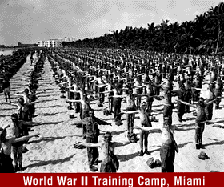World War II and Post-War Boom
World War II spurred economic development in Florida. Because of its year-round mild climate, the state became a major training center for soldiers, sailors, and aviators of the United States and its allies. Highway and airport construction accelerated so that, by war's end, Florida had an up-to-date transportation network ready for use by residents and the visitors who seemed to arrive in an endless stream.

One of the most significant trends of the postwar era has been steady population growth, resulting from large migrations to the state from within the U.S. and from countries throughout the western hemisphere, notably Cuba and Haiti. Florida is now the third most populous state in the nation.
The people who make up Florida's diverse population have worked to make the Sunshine State a place where all citizens have equal rights under the law. Since the 1950s, Florida's public education system and public places have undergone great changes. African American citizens, joined by Governor LeRoy Collins and other white supporters, fought to end racial discrimination in schools and other institutions.
Since World War II, Florida's economy also has become more diverse. Tourism, cattle, citrus, and phosphate have been joined by a host of new industries that have greatly expanded the numbers of jobs available to residents. Electronics, plastics, construction, real estate, and international banking are among the state's more recently-developed industries.
 Several major U.S. corporations have moved their headquarters to Florida. An interstate highway system exists throughout the state, and Florida is home to major international airports. The university and community college system has expanded rapidly, and high-technology industries have grown steadily. The U.S. space program—with its historic launches from Cape Canaveral, lunar landings, and the development of the space shuttle program—has brought much media attention to the state. The citrus industry continues to prosper, despite occasional winter freezes, and tourism also remains important, bolstered by large capital investments. Florida attractions, such as the large theme parks in the Orlando area, bring millions of visitors to the state from across the U.S. and around the world
Several major U.S. corporations have moved their headquarters to Florida. An interstate highway system exists throughout the state, and Florida is home to major international airports. The university and community college system has expanded rapidly, and high-technology industries have grown steadily. The U.S. space program—with its historic launches from Cape Canaveral, lunar landings, and the development of the space shuttle program—has brought much media attention to the state. The citrus industry continues to prosper, despite occasional winter freezes, and tourism also remains important, bolstered by large capital investments. Florida attractions, such as the large theme parks in the Orlando area, bring millions of visitors to the state from across the U.S. and around the world
Today, Floridians study their state's long history to learn more about the lives of the men and women who shaped their exciting past. By learning about our rich and varied heritage, we can draw lessons to help create a better Florida for all of its citizens.
